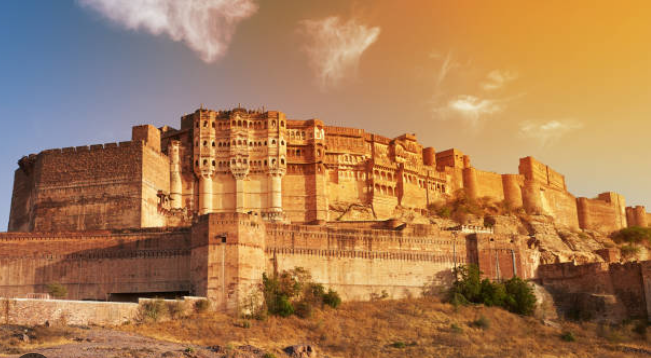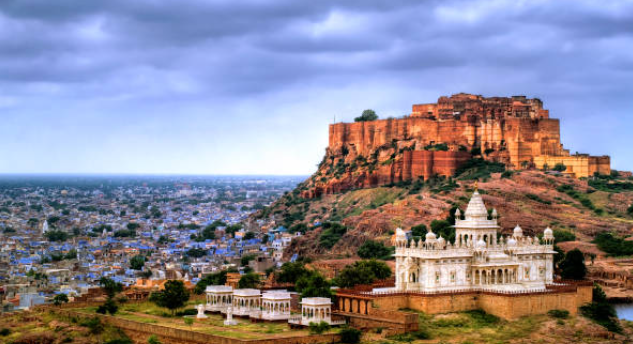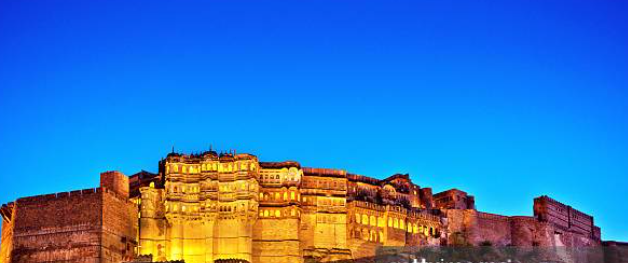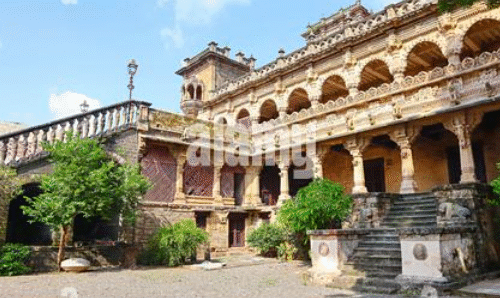Mehrangarh Fort, one of the largest and most magnificent forts in India, stands tall and proud in the heart of Jodhpur, Rajasthan. With its awe-inspiring architecture, rich history, and strategic location, Mehrangarh has become a must-visit landmark for those seeking to explore the royal legacy of Rajasthan. This fort is a testament to the region’s past, reflecting the power and grandeur of the Marwar kings who once ruled here.
Location of Mehrangarh Fort
Mehrangarh Fort is located in Jodhpur, a city in the northwestern part of India. It sits atop a 150-meter-high hill, offering a panoramic view of the entire city and its surroundings. The fort’s location made it strategically important for defense, as it overlooked the ancient trade routes that passed through the region. The fort is easily accessible from the city, and its towering presence dominates the skyline of Jodhpur.

History of Mehrangarh Fort
Mehrangarh Fort was founded in 1460 by Rao Jodha, the ruler of Marwar. According to historical records, Rao Jodha moved his capital from Mandore to the present location to strengthen the defense of his kingdom. The fort was initially built as a military stronghold and gradually expanded over centuries. The fort has witnessed many historical events, including numerous battles, royal events, and the rise and fall of rulers.

Over time, the fort became a symbol of Marwar’s glory, housing the royal family and their treasures. The fort’s structure was added to and modified by successive generations of rulers. Today, it houses an impressive museum showcasing artifacts, paintings, and weaponry that offer insight into Rajasthan’s royal past. The fort’s history is not just a reflection of military might but also of cultural evolution, with elements of both Mughal and Rajput architecture blending seamlessly within its walls.
Architecture and Design
Mehrangarh Fort is known for its distinctive architecture, a combination of Mughal and Rajput styles. The fort’s massive walls are made from sandstone, which gives it a reddish-brown hue, creating a beautiful contrast with the blue-painted houses in Jodhpur. The fort covers an area of around 5 square kilometers and is surrounded by a high wall with seven gates, each with its own significance and history.
The design of the fort is intricate, with a series of courtyards, palaces, temples, and museums inside. The fort’s palace area consists of several beautifully designed rooms and halls, each decorated with exquisite carvings, paintings, and intricate woodwork. Some of the notable rooms in the fort include the Phool Mahal (Flower Palace), the Moti Mahal (Pearl Palace), and the Sheesh Mahal (Mirror Palace). These spaces reflect the opulence and elegance of the royal family that once resided here.
The fort also boasts stunning balconies, arches, and windows that allow visitors to experience the fort’s grandeur and the panoramic views of the city below. The high walls and strategic location made it nearly impregnable, offering protection during times of war and political unrest.

Key Features of Mehrangarhe Fort
- Massive Walls and Gates
The fort is surrounded by massive walls that rise up to 36 meters in height. The seven gates, including the famous Jai Pol (Victory Gate) and Fatteh Pol (Gate of Victory), were built to commemorate significant military victories. The walls themselves are adorned with bullet marks and inscriptions, offering a glimpse into the fort’s history of warfare and triumph. - The Museum
Mehrangarh Fort houses an excellent museum that showcases the royal history of Marwar. Visitors can explore a wide range of artifacts, including royal portraits, antique weapons, textiles, and musical instruments. The museum provides a comprehensive understanding of the lifestyle, culture, and history of the region’s rulers. - Temples and Shrines
Within the fort’s walls, there are several temples dedicated to Hindu gods. The Chamunda Mata Temple is one of the most prominent, as it is believed to be the protective deity of the fort and its rulers. Pilgrims and visitors alike come to pay their respects here, contributing to the spiritual significance of Mehrangarh. - Scenic Views
One of the most attractive features of Mehrangarh Fort is the stunning views it offers. The fort provides an unparalleled view of the blue city of Jodhpur, with its labyrinthine alleys and characteristic blue-painted houses. The fort also overlooks the arid landscape of Rajasthan, adding to the charm and majesty of the location. - Cultural Events and Festivals
Mehrangarh Fort is not just a historical site; it also hosts cultural events and festivals that attract visitors from all over the world. These events include traditional Rajasthani music and dance performances, exhibitions, and festivals like the Jodhpur RIFF (Rajasthan International Folk Festival), which takes place annually within the fort. - Preservation and Tourism
Mehrangarh Fort has been well-preserved and is one of the most visited tourist destinations in Rajasthan. The fort has been maintained by the Mehrangarh Trust, which works to conserve the fort’s heritage and promote cultural tourism. The trust also supports various initiatives aimed at preserving Rajasthan’s traditional arts and crafts.
Conclusion
Mehrangarh Fort is a beautiful and historically significant site that offers a glimpse into Rajasthan’s royal past. Its strategic location, breathtaking architecture, and rich history make it one of the most important landmarks in India. The fort not only serves as a symbol of strength and resilience but also as a cultural hub that continues to engage visitors with its timeless beauty. Whether you’re a history enthusiast, an architecture lover, or a traveler seeking to explore the royal heritage of Rajasthan, Mehrangarh Fort is a place that will leave you in awe.


